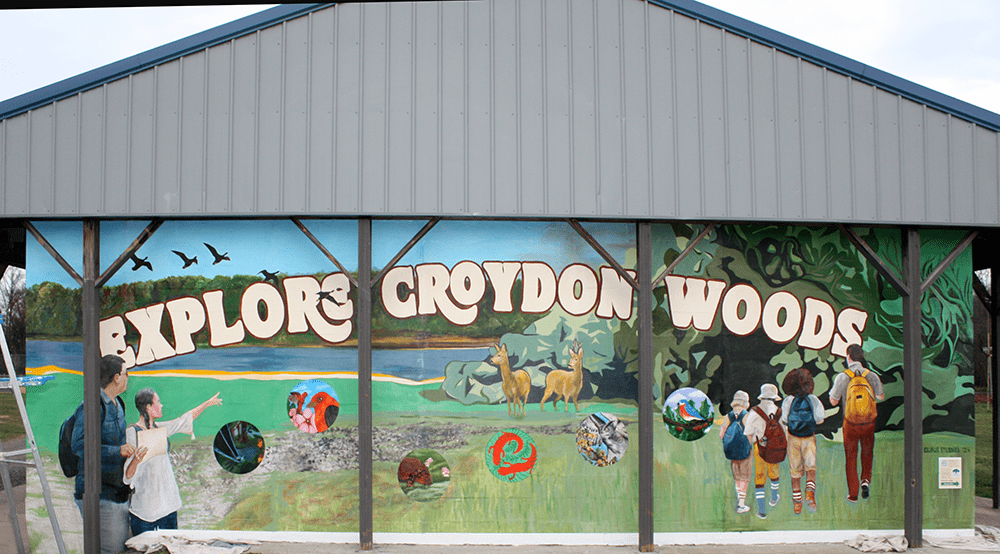Estimated reading time: 8 minutes
In this Blog
Great murals aren’t just visually striking—they open conversations, shift perceptions, and bring people together. At Dubus Studio, we believe murals should tell stories worth hearing. One project showcases this belief. It is our Croydon Woods mural, created in partnership with Heritage Conservancy and Truman High School. It’s a living example of reclaiming public spaces with art—literally painting a new chapter for a place once unsafe.
Murals can do more than just decorate—they have the power to change how people see a place. When a space has a difficult past, art serves as a powerful tool. It helps to reclaim the space with hope, connection, and pride. That’s what we set out to do in Croydon, PA.
Use Case: Croydon Woods Mural – Reframing a Community Through Art
Commissioned in spring 2024, the Croydon Woods mural now adorns a building at the entrance to the preserve. This mural was more than a beautification effort. It was a community mural transformation. It reintroduced the public to Croydon Woods’ healing story.
This site had once been designated a federal Superfund location, meaning it was deemed hazardous due to toxic waste. Decades of environmental damage had kept residents away, and public perception of the woods was colored by fear and neglect. But behind the contamination was a natural gem waiting to be restored.
Heritage Conservancy led the cleanup and conservation efforts, working hard to reclaim the space for public enjoyment. As the final touch, they turned to art. Dubus Studio was invited to help. They aimed to create something that would act as both a landmark and a symbol of transformation.
Environmental Storytelling Through Murals
The mural design was rooted in environmental storytelling through murals, featuring native species, plants, and local ecological history. We focused on elements that were unique to Croydon Woods. These include its wetlands and its diverse habitats. Many species are now thriving there.
I worked closely with students from nearby Truman High School and the Heritage Conservancy team to gather ideas and inspiration. Students provided sketches, research, and even selected species they wanted represented in the mural. Their involvement gave them a personal stake in the project—and brought fresh energy to the design process.
By incorporating real voices and environmental themes, the mural became a visual narrative about rebirth and resilience. These eco murals serve not just to beautify but to educate and remind viewers of the importance of stewardship.
Mural Collaboration with Students
One of the most rewarding aspects of this project was working with student artists. For many of them, it was their first time contributing to public art. Through this mural collaboration with students, they experienced first-hand how their creativity impact their own neighborhood.
We held multiple painting sessions at the site. Students helped lay in background colors. They filled in wildlife imagery and contributed signature brushstrokes to the final piece. Their energy was contagious, and their participation made the mural feel truly community-owned.
Art becomes even more powerful when young people are empowered to lead and shape the story. This project underscored the value of youth mural projects as both art and education.
How to Design Murals for Public Spaces
Every phase of this mural followed best practices for how to design murals for public spaces. That includes site analysis, story-boarding, sketching, and testing colors on location.
We created mood-boards with local photography. We used digital mockups to plan layout and balance. We also selected paints built to withstand outdoor conditions. The composition was designed to be readable from a distance and to encourage passersby to pause and engage.
Designing murals in public requires more than just artistic talent—it takes logistics, community engagement, and planning. And in a sensitive site like Croydon Woods, it also meant staying true to its ecological mission.
Reclaiming Public Spaces with Art
This mural blended environmental education with public art, showcasing the impact of eco murals in formerly neglected places. Students who had never visited Croydon Woods now felt ownership and curiosity. The mural’s visibility helped reframe public opinion about the site—a powerful example of reclaiming public spaces with art.
Public art has the unique ability to say, “This place matters.” And when the place has been forgotten or feared, that statement becomes even more powerful. Art helps rewrite narratives—not just on walls, but in people’s minds.
A Broader Impact: Art Meets Environmental Stewardship
As covered by WHYY, Croydon Woods went from a federal Superfund cleanup to an award-winning environmental preserve. Public murals like this one become visual declarations of rebirth. They show what’s possible when communities invest in art for healing spaces. They also celebrate their stories.
This mural has become a symbol of community pride. It serves as an educational resource. It also acts as an inspiration for what future collaborations can look like. It’s not just a painting—it’s a landmark that reminds us what’s possible when we come together.
Conclusion
The Croydon Woods mural isn’t just a piece of art—it’s a celebration of transformation. It brought together students, conservationists, artists, and neighbors. It tells a story that matters and leaves a legacy for future generations.
Related Links
Looking to Bring the Magic of Storytelling to Your Own Space?
- Turn your vision into reality!
- Let’s discuss how a collaborative mural project can inspire your community.
- Discover the benefits of a mural creation and contact me today for a free consultation!


Leave a Reply